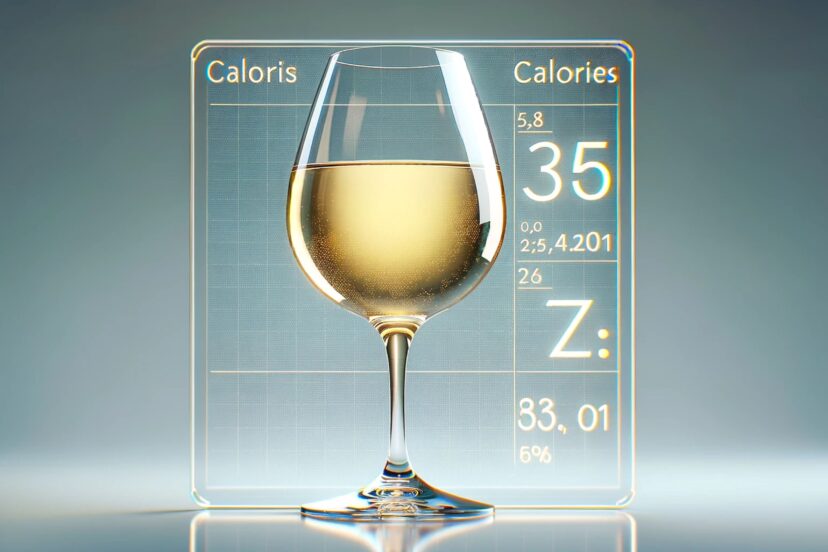Calories in Glass of White Wine: A Comprehensive Guide
Post Disclaimer
*We may earn a commission for purchases made using our links. Please see our disclosure to learn more.
Curious about how many calories are in your glass of white wine? You’re not alone. Many wine lovers and health-conscious individuals wonder about the calorie content in their favorite white wines.
A regular glass of white wine contains roughly 120 to 130 calories, a fact that might surprise those keeping an eye on their daily intake.
This article aims to guide you through understanding the caloric content of white wine – from a single glass to an entire bottle. We’ll explore how sweetness, alcohol content, and serving size can change these numbers.
Plus, we’ll share some tips on choosing options with fewer calories without sacrificing enjoyment. Ready to learn more? Keep reading!
Understanding White Wine Calories
White wine calories can vary based on the type of wine, with factors such as sweetness and alcohol content influencing the calorie count. Serving size also plays a role in determining the caloric intake from white wine.
Calories in a glass of white wine
A typical glass of white wine contains about 120 to 130 calories. This number can change based on the type of white wine you choose. Dry wines, for example, often have fewer calories than sweet ones because they contain less sugar.
The alcohol content also plays a role in how many calories are in your glass; higher alcohol wines tend to have more calories.
Counting calories in different types of white wine helps people stay informed about their consumption. A serving size, which is usually around 5 ounces for wine, significantly impacts the total calorie intake from each glass.
Wine enthusiasts and casual drinkers alike benefit from knowing these details to make better choices that fit within their lifestyle or diet plans.
Calories in a bottle of white wine
A bottle of white wine contains approximately 635 calories on average, with popular varieties ranging from 600 to 700 calories per standard-sized bottle. To enjoy your favorite white wine while being mindful of calorie intake, consider opting for dry wines instead of sweet ones and keeping an eye on alcohol content.
Additionally, choosing smaller serving sizes can help in managing caloric consumption without sacrificing the pleasure of a good glass of wine.
Typical white wine calories
White wine calories vary but typically range from 110 to 140 calories per 5-ounce (150 ml) serving. The exact calorie count depends on factors such as the specific variety, sweetness level, and alcohol content of the wine.
Some popular white wines like Chardonnay or Sauvignon Blanc generally fall within this calorie range, making them relatively moderate choices for those conscious of their caloric intake.
White wine calories can easily fit into a balanced diet when consumed in moderation, especially if paired with lighter meals. Understanding the typical calorie content can help individuals make informed choices about their wine consumption without sacrificing enjoyment.
Factors Affecting White Wine Calories
The sweetness of the wine, the alcohol content, and serving size all impact the caloric content of white wine. These factors directly influence the calorie count in your favorite glass or bottle of white wine.
Sweetness of the wine
The sweetness of the wine directly impacts its calorie content. Sweeter white wines tend to have more calories due to the higher sugar content. This is because fermentation converts grape sugar into alcohol, but when a wine contains residual sugars (like in sweet wines), these add to the overall calorie count.
The degree of sweetness of a wine can vary from bone dry to lusciously sweet, and each style will have different caloric implications. It’s important to keep this in mind when considering your calorie intake from white wine.
Alcohol content
White wine’s alcohol content directly impacts its calorie count. Alcohol itself contributes significantly to the caloric load of a glass or bottle of white wine. The higher the alcohol content, the more calories are present in your drink.
So when selecting a white wine, keep an eye on its alcohol by volume (ABV) percentage and opt for those with lower ABV levels to reduce your calorie intake while still enjoying your favorite beverage.
Understanding how different factors affect the caloric value of white wine can help you make informed choices about what and how much to drink. Let’s move on to explore another critical factor that influences the caloric content of this beloved libation: serving size.
Serving size
A standard serving of white wine typically consists of 5 ounces. Opting for a smaller serving size can help manage your calorie intake while still allowing you to enjoy a glass of white wine.
It’s essential to be mindful of the portion you pour, as larger servings will naturally contain more calories.
Next up: “Tips for Reducing White Wine Calories”
Tips for Reducing White Wine Calories
Choose dry wines, opt for smaller serving sizes, and be mindful of mixers and additives to enjoy your white wine with fewer calories. For more insights on managing your wine consumption, do explore our article further.
Choose dry wines
Selecting dry wines can significantly reduce the calorie content of your glass. Dry wines have lower residual sugar, translating to fewer calories and a more crisp, less sweet taste.
Opt for varieties like Chardonnay, Sauvignon Blanc, or Pinot Grigio when watching your calorie intake while savoring a glass of wine.
Opt for smaller serving sizes
Choose smaller serving sizes to reduce caloric intake. By opting for a smaller glass, you can enjoy your favorite white wine while managing your calorie consumption. This simple adjustment allows you to savor the taste without worrying about excessive caloric content.
For those conscious of their diet and nutrition, selecting smaller portions makes it easier to indulge in a glass of white wine without exceeding your desired calorie limit.
Be mindful of mixers and additives
When enjoying your glass of white wine, be cautious about the mixers and additives you use. Opt for natural ingredients like fresh fruits or herbs to enhance the flavor without adding unnecessary calories or sugar to your drink.
Avoid sugary syrups, sodas, and fruit juices that can significantly increase the calorie count of your wine-based cocktails. By being mindful of mixers and additives, you can savor the pure flavors of your white wine without compromising on its caloric content.
To fully appreciate the essence of your white wine, it’s essential to be attentive towards mixers and additives. Carefully chosen additions like citrus zest or a splash of sparkling water can complement the intricate notes in your drink without overwhelming its delicate profile.
Conclusion
Unlock the secrets of white wine calories by understanding the factors that affect their count. Make informed choices to enjoy your favorite beverage while keeping an eye on calorie consumption.
Tailor your wine selection and serving sizes to fit into your diet plan effortlessly. Enjoy a glass of white wine without worrying about its caloric impact with these insightful tips.
FAQs
1. How many calories are in a glass of white wine?
A glass of white wine typically contains about 120 to 130 calories, but this can vary depending on the variety and serving size.
2. Are there more calories in a bottle of white wine compared to red wine?
Yes, a bottle of white wine generally has fewer calories than a bottle of red wine because red wines often have higher alcohol content which increases calorie count.
3. Can I drink white wine while on a diet?
Yes, you can enjoy white wine in moderation while on a diet. Pay attention to the caloric content and serving size to keep your consumption within your dietary limits.
4. What determines the calorie count in a glass of white wine?
The calorie count in a glass of white wine is determined by its alcohol content and sugar levels, with sweeter varieties usually having more calories.
5. Do all types of white wines have the same number of calories?
No, different varieties of white wines have varying caloric contents. For example, dry varieties tend to have fewer calories compared to sweet or dessert wines.




